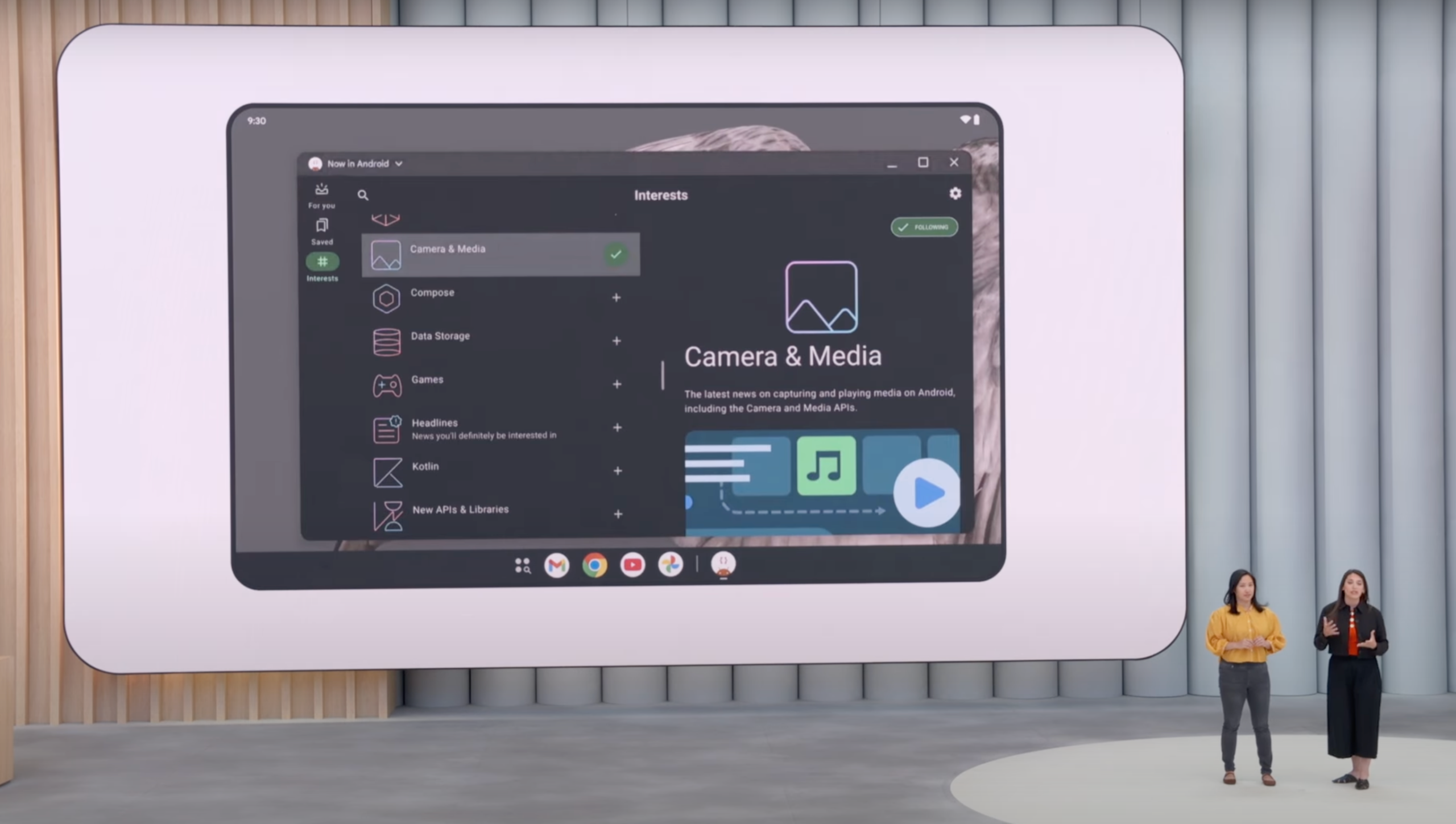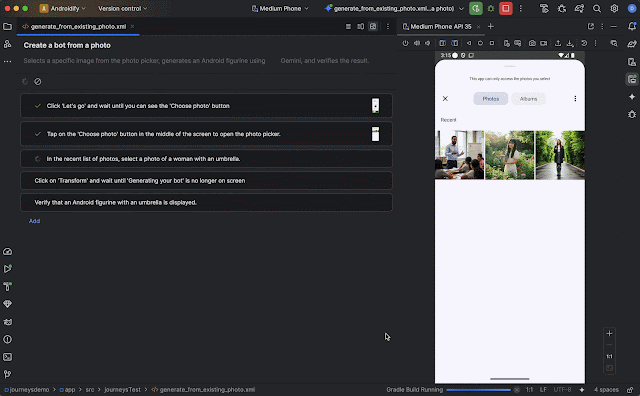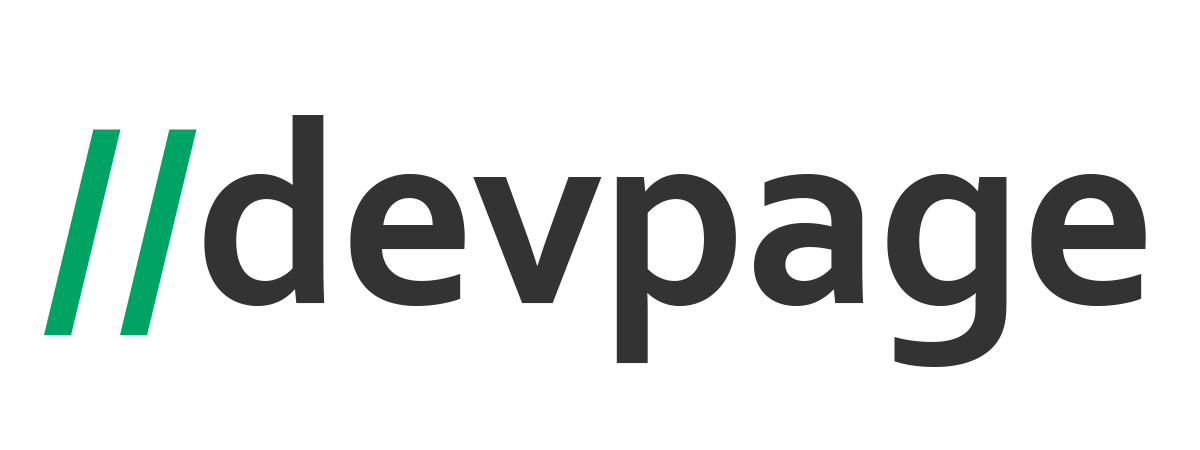Google I/O 2025 packed two keynotes, more than 150 technical sessions, and enough acronyms to make any veteran engineer reach for coffee – but buried in the hype were landmark changes that will shape everyday mobile workflows. This article distills the noise into the updates that actually alter the way you code, debug, release, and monetize Android apps right now. From the first Android 16 beta and Gemini-everywhere AI to a Wear OS renaissance and stricter Play Integrity rules, here is everything you need in one coffee-length read.
Android 16 – Adaptive, Desktop-Ready & Built for Large Screens
Google reserved the opening salvo for Android 16, pushing the platform from nice-to-have tablet tweaks to a genuinely adaptive stack that scales from phones to tablets, foldables, Chromebooks, cars, and even Samsung-style desktop shells. The headline demo showed a DeX-like environment where Gmail, Chrome, and Photos floated in fully resizable windows – a capability driven by new window-manager APIs arriving in the first beta.
Material 3 Expressive – Google’s next iteration of Material You – layers dynamic type, richer motion, and theme-aware color harmonies onto every Android surface, delivering a consistent look that now matches the same design language rolling out to Wear OS and XR.
Under the hood, Android 16 Beta 1 exposes high-level APIs for multidevice awareness, a privacy-first live notification style called Live Update, and the long-teased partial screen-recording API. Platform Stability is slated for Beta 3 in March, giving libraries and OEM SKUs a predictable freeze date.

Gemini Everywhere – Google’s AI Model Moves Into Your IDE & Runtime
If I/O 2024 hinted that AI would seep into Android tooling, 2025 proved it. The new Gemini 2.5 Pro model is baked into Android Studio under an umbrella dubbed Agentic AI – think pair programming on autopilot. Type a natural-language description, and Gemini generates an entire Jetpack Compose preview or rewrites a layout on the fly.
Studio’s Journeys feature turns the same model loose on testing: describe a user flow in English, and Gemini scripts Espresso-style tests, runs them, and surfaces annotated results directly in the IDE. It is experimental but already shaving hours off QA cycles.
Developers can now attach screenshots, mock-ups, or even entire project files to Gemini chat. The assistant parses context, offers targeted suggestions, and applies code changes after a diff review – an approach that moves well beyond autocomplete.
Google’s bigger AI splash, however, came from Jules – an asynchronous coding agent launched in public beta. Unlike Copilot’s inline suggestions, Jules accepts multiple backlog items, works in the background, and returns pull requests when tasks are complete. Git integration is turnkey, and the beta is open without a wait-list.

Android Studio Narwhal Feature Drop – Smarter, Faster, Safer
The Narwhal 2025.2 canary ships the first Feature Drop: crash insights that not only detect the root cause in connected Crashlytics traces but also generate a one-click patch. The App Quality Insights panel now surfaces a Gemini-written fix beside the offending diff, ready for developer approval.
Live Edit picks up performance boosts, and the manual shortcut changes to Ctrl/⌘+', addressing long-standing conflicts with IDE split shortcuts. Compose Preview gains “Transform UI with Gemini,” letting you issue natural-language commands like “reduce card padding” and watch code update in real time.
Finally, Studio Labs graduates to stable builds, so you no longer need Canary for AI experiments. Toggle Labs in Settings → Studio Labs, enable features, and they automatically sync to new releases.

Jetpack Compose 1.8 – Performance & Multiplatform Polish
Google claims 60 percent of the top-1000 Play apps now rely on Compose, and version 1.8 doubles down on performance: the compiler plugin reduces recomposition overhead by 22 percent on complex lists, and new baseline profiles can be generated in IDE with a single action.
CameraX, Media3, and ConstraintLayout wrappers land in the Compose library set, trimming boilerplate when integrating camera previews or advanced media controls. Meanwhile, Compose Multiplatform aligns with the mainline 1.8 APIs, smoothing the path for shared UI between Android and desktop.
Kotlin 2.1 (K2) – A Quiet but Crucial Compiler Leap
While Kotlin announcements slipped into the “What’s New in Android” session rather than the keynote, JetBrains and Google jointly confirmed that the K2 compiler is now stable for Android. Developers can opt-in via Gradle kotlin.experimental.tryK2=true, gaining 30–40 percent faster incremental builds, better diagnostics, and full support for context receivers.
Kotlin Multiplatform saw parity boosts as well: expect improved memory-managed collections on iOS targets and fresh Compose Desktop templates. These changes, though less flashy than Gemini, directly cut CI times and memory usage in large Android repos.
Google Play & Distribution – New Integrity Signals, Subscription Tweaks
On the business side, the Play Integrity API gains device recall (beta) – a privacy-preserving server-side flag that lets you identify devices repeatedly linked to abuse, without storing personal identifiers. It effectively replaces SafetyNet’s old device ban lists with cryptographically rotated IDs.
Play Billing Library 6 becomes the required version for new submissions after November 1. The new library fully deprecates AIDL IAB calls and introduces the monetization .subscriptions API that lets you create multiple pricing phases (intro, grace, second chance) directly in Play Console Drafts. Readiness warnings will surface in Android Studio if you target an older billing library.
Google Play also gains a revamped “Custom Promotions” program that allows devs to surface codes, offers, or dynamic pricing slots in search and home before users install your app – a subtle but important conversion hook.
Wear OS 6 – Material 3 Expressive & Credential Manager
Wear OS – once the neglected cousin of Android TV – gets its biggest refresh in years. Material 3 Expressive brings dynamic color and typography that adapts to the watch face palette, while a new Credential Manager API finally standardizes sign-in flows on wrist-bound devices.
The Wear Compose Material 3 and ProtoLayout libraries arrive in alpha, mirroring the mobile Compose APIs and making it trivial to share UI strategy across form factors. Battery life improvements hover around 10 percent on Pixel Watch 3 preview builds, thanks to more aggressive background-activity limits.
Multidevice, XR & Cross-Form-Factor Tooling
The Multidevice SDK adds an @DeviceGroup annotation that abstracts discovery and streaming, meaning you can sling an in-progress media session from phone to tablet or ChromeOS with three lines of Kotlin. Meanwhile, Developer Preview 2 of the Android XR SDK opens up Unity and Unreal plugins for stereoscopic rendering.
Adaptive Layout guidance rolled out as interactive codelabs, emphasizing constraint-based design and window-size classes. Practical payoff: one layout resource can now cover phone, tablet, desktop, car display, and XR headset with minor tweaks.
Firebase & Cloud – On-Device AI Meets Serverless
Firebase’s “AI Logic” SDK graduates to public preview, providing thin wrappers around Gemini and Imagen endpoints plus on-device fallbacks via Google’s Tiny Gemini model. Edge caching reduces token costs and averts latency spikes when your user’s network drops during inference calls.
Performance Monitoring now automatically correlates slow traces with Android Studio’s App Quality Insights crash clusters, closing the loop between cloud and IDE dashboards. The result is a single, unified timeline that shows cold-start regressions alongside crash spikes after a release.
Security – Mandatory Auto-Reboot & Live Threat Detection
Android 16 enables a three-day locked-state auto-reboot flag as a core security layer. When enabled by OEMs, a phone or tablet that has not been unlocked for 72 hours will reboot, clearing biometric tokens and forcing a PIN entry. Userland code only needs to handle the extra boot-complete broadcast.
Complementing the auto-reboot, Play Protect’s new Live Threat Detection pipes real-time native binary scanning to the cloud, reaching parity with Apple’s on-device ML malware scanner. Apps executing suspicious obfuscation patterns can be blocked before first launch – so test your release builds with adb shell pm install-test on the new emulator images.
Five Action Items Before You Ship Your Next APK
Bump APIs and Test Windowing
Download Android 16 emulator images, enable the desktop-class window flag, and test your adaptive layouts at eight or more size classes. UseWindowSizeClasshelpers to avoid hard-coding dp thresholds.Opt-In to Gemini Features
Grab Android Studio Narwhal Canary, toggle Enable Gemini under Studio Labs, and try the Journey test generator on an existing Espresso test suite. It will surface AI diff hunks you can approve into Git.Migrate to Play Billing 6
Search forimplementation 'com.android.billingclient:billing:5'in your Gradle files; if present, replace with v6 and run the newgradle lintReleasetask to ensure you handle every pending intent change.Harden Integrity
Integrate therecallDeviceProtection()call from the latest Integrity API sample, then set thresholds in Play Console to automatically block repeat offenders without disrupting legitimate users.Refresh Wear Tiles
If your app offers a Wear tile, migrate to the new Material 3 ProtoLayout library. Most XML layouts convert with the Android Studio → Refactor → Migrate to ProtoLayout M3 wizard.Google I/O 2025 was less about moonshot reveals and more about stitching AI into every seam of the Android toolchain, tightening design cohesion across devices, and nudging developers toward adaptive, privacy-first apps. Gemini-infused workflows shorten dev loops, Android 16 flattens the windowing gap across form factors, and Play policies continue maturing toward security and user trust. Take a weekend to install the betas, refactor your layouts, and enable the Integrity enhancements – the groundwork you lay now will pay dividends when Android 16 ships to consumers later this year.


